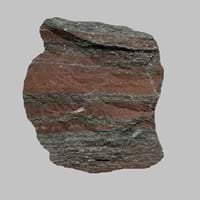Definition
Jaspillite is an iron rich chemically formed rock which is common in banded iron formation rocks
Mylonite is a metamorphic rock formed by ductile deformation during intense shearing encountered during folding and faulting, a process termed cataclastic or dynamic metamorphism
Origin
Western Australia, Minnesota
New Zealand
Discoverer
Unknown
Unknown
Etymology
From Jaspilite (Mineral), a compact siliceous rock which resembles jasper
From Greek mulōn mill + -ite
Class
Sedimentary Rocks
Metamorphic Rocks
Sub-Class
Durable Rock, Soft Rock
Durable Rock, Medium Hardness Rock
Group
Not Applicable
Not Applicable
Other Categories
Coarse Grained Rock, Opaque Rock
Fine Grained Rock, Opaque Rock
Texture
Banded, Trellis
Foliated
Color
Red, Reddish Brown
Black to Grey
Durability
Durable
Durable
Appearance
Banded and Glassy
Dull, Banded and Foilated
Interior Uses
Decorative Aggregates, Interior Decoration
Decorative Aggregates, Interior Decoration
Exterior Uses
As Facing Stone, Garden Decoration, Paving Stone
As Building Stone, As Facing Stone, Paving Stone, Garden Decoration
Other Architectural Uses
Curbing
Curbing
Construction Industry
As a Flux in the Production of Steel and Pig Iron, As a Sintering Agent in Steel Industry to process Iron Ore, As Dimension Stone, Cement Manufacture, for Road Aggregate, Making natural cement, Manufacture of Magnesium and Dolomite Refractories
for Road Aggregate, Landscaping, Roadstone
Medical Industry
Not Yet Used
Not Yet Used
Antiquity Uses
Artifacts, Jewellery, Monuments
Artifacts, Monuments
Commercial Uses
Creating Artwork, Jewelry
Creating Artwork, Gemstone, Jewelry
Types
Algoma-type , Lake Superior-type and Superior-type
Blastomylonites, Ultramylonites and Phyllonites
Features
Is one of the oldest rock
Surfaces are often shiny
Archaeological Significance
Famous Monuments
Data Not Available
Data Not Available
Sculpture
Not Yet Used
Used
Famous Sculptures
Not Applicable
Data Not Available
Figurines
Not Yet Used
Used
Formation
Jaspillite is a type of sedimentary rock which is formed by the compaction and sedimentation of pieces of broken or weathered rocks and minerals.
Mylonites are ductilely deformed rocks formed by the accumulation of large shear strain, in ductile fault zones.
Mineral Content
Coesite, Quartz, Sand
Porphyroblasts
Compound Content
Fe, Iron(III) Oxide, Silicon Dioxide
Aluminium Oxide, Calcium Sulfate, Chromium(III) Oxide, Iron(III) Oxide, Magnesium Carbonate, Silicon Dioxide
Types of Metamorphism
Not Applicable
Not Applicable
Types of Weathering
Biological Weathering, Chemical Weathering
Biological Weathering, Chemical Weathering, Mechanical Weathering
Types of Erosion
Chemical Erosion, Coastal Erosion
Chemical Erosion, Sea Erosion, Wind Erosion
Grain Size
Large and Coarse Grained
Fine Grained
Fracture
Conchoidal
Conchoidal
Porosity
Very Less Porous
Highly Porous
Cleavage
Imperfect
Conchoidal
Toughness
Not Available
Not Available
Specific Gravity
5.0-5.3
2.97-3.05
Transparency
Translucent to Opaque
Opaque
Density
0-5.7 g/cm3
2.6-4.8 g/cm3
Resistance
Heat Resistant, Impact Resistant, Wear Resistant
Heat Resistant, Impact Resistant, Pressure Resistant
Deposits in Eastern Continents
Asia
Russia
China, India, Indonesia, Saudi Arabia, South Korea
Africa
Not Yet Found
Eritrea, Ethiopia, Ghana, South Africa, Western Africa
Europe
Ukraine
England, Finland, France, Germany, Great Britain, Greece, United Kingdom
Others
Not Yet Found
Not Yet Found
Deposits in Western Continents
North America
Canada, USA
USA
South America
Brazil
Not Yet Found
Deposits in Oceania Continent
Australia
Western Australia
Central Australia, Western Australia
Jaspillite vs Mylonite Characteristics
Though some rocks look identical, they have certain characteristics which distinguish them from others. Characteristics of rocks include texture, appearance, color, fracture, streak, hardness etc. Jaspillite vs Mylonite characteristics assist us to distinguish and recognize rocks. Also you can check about Properties of Jaspillite and Properties of Mylonite. Learn more about Jaspillite vs Mylonite in the next section. The interior uses of Jaspillite include Decorative aggregates and Interior decoration whereas the interior uses of Mylonite include Decorative aggregates and Interior decoration. Due to some exceptional properties of Jaspillite and Mylonite, they have various applications in construction industry. The uses of Jaspillite in construction industry include As a flux in the production of steel and pig iron, As a sintering agent in steel industry to process iron ore, As dimension stone, Cement manufacture, For road aggregate, Making natural cement, Manufacture of magnesium and dolomite refractories and that of Mylonite include For road aggregate, Landscaping, Roadstone.
More about Jaspillite and Mylonite
Here you can know more about Jaspillite and Mylonite. The life cycle of a rock consists of formation of rock, composition of rock and transformation of rock. The composition of Jaspillite and Mylonite consists of mineral content and compound content. The mineral content of Jaspillite includes Coesite, Quartz, Sand and mineral content of Mylonite includes Porphyroblasts. You can also check out the list of all Sedimentary Rocks. When we have to compare Jaspillite vs Mylonite, the texture, color and appearance plays an important role in determining the type of rock. Jaspillite is available in red, reddish brown colors whereas, Mylonite is available in black to grey colors. Appearance of Jaspillite is Banded and Glassy and that of Mylonite is Dull, Banded and Foilated. Properties of rock is another aspect for Jaspillite vs Mylonite. The hardness of Jaspillite is 3 and that of Mylonite is 3-4. The types of Jaspillite are Algoma-type , Lake Superior-type and Superior-type whereas types of Mylonite are Blastomylonites, Ultramylonites and Phyllonites. Streak of rock is the color of powder produced when it is dragged across an unweathered surface. The streak of Jaspillite and Mylonite is white. The specific heat capacity of Jaspillite is 3.20 kJ/Kg K and that of Mylonite is 1.50 kJ/Kg K. Depending on the properties like hardness, toughness, specific heat capacity, porosity etc., rocks are resistant to heat, wear, impact, etc.Jaspillite is heat resistant, impact resistant, wear resistant whereas Mylonite is heat resistant, impact resistant, pressure resistant.





